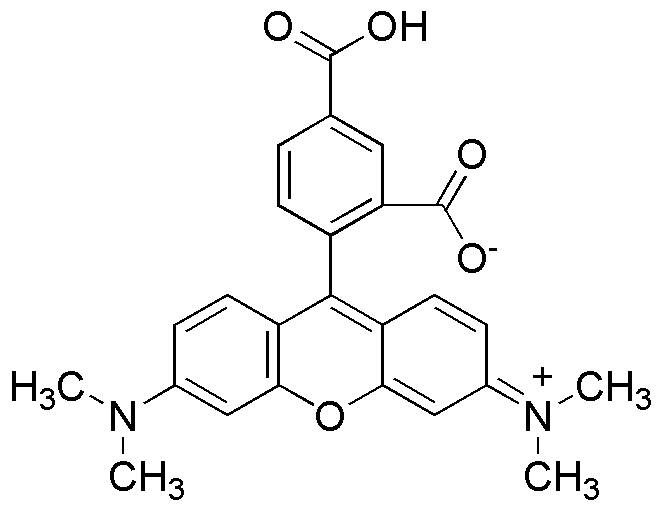5-Carboxy-tetramethylrhodamine is widely utilized in research focused on:
- Fluorescent Labeling: This compound is commonly used as a fluorescent dye in biological research, allowing scientists to tag and visualize proteins and other biomolecules in live cells.
- Imaging Techniques: It plays a crucial role in advanced imaging techniques such as fluorescence microscopy, providing high-resolution images that help researchers study cellular processes in detail.
- Flow Cytometry: The compound is employed in flow cytometry applications, enabling the analysis of cell populations based on their fluorescent characteristics, which is vital in immunology and cancer research.
- Drug Development: In pharmaceutical research, it aids in tracking drug delivery and distribution within biological systems, enhancing the understanding of pharmacokinetics and drug efficacy.
- Environmental Monitoring: This chemical is also used in environmental science to trace pollutants and study their interactions in ecosystems, contributing to ecological research and conservation efforts.
General Information
Properties
Safety and Regulations
Applications
5-Carboxy-tetramethylrhodamine is widely utilized in research focused on:
- Fluorescent Labeling: This compound is commonly used as a fluorescent dye in biological research, allowing scientists to tag and visualize proteins and other biomolecules in live cells.
- Imaging Techniques: It plays a crucial role in advanced imaging techniques such as fluorescence microscopy, providing high-resolution images that help researchers study cellular processes in detail.
- Flow Cytometry: The compound is employed in flow cytometry applications, enabling the analysis of cell populations based on their fluorescent characteristics, which is vital in immunology and cancer research.
- Drug Development: In pharmaceutical research, it aids in tracking drug delivery and distribution within biological systems, enhancing the understanding of pharmacokinetics and drug efficacy.
- Environmental Monitoring: This chemical is also used in environmental science to trace pollutants and study their interactions in ecosystems, contributing to ecological research and conservation efforts.
Documents
Safety Data Sheets (SDS)
The SDS provides comprehensive safety information on handling, storage, and disposal of the product.
Product Specification (PS)
The PS provides a comprehensive breakdown of the product’s properties, including chemical composition, physical state, purity, and storage requirements. It also details acceptable quality ranges and the product's intended applications.
Certificates of Analysis (COA)
Search for Certificates of Analysis (COA) by entering the products Lot Number. Lot and Batch Numbers can be found on a product’s label following the words ‘Lot’ or ‘Batch’.
*Catalog Number
*Lot Number
Certificates Of Origin (COO)
This COO confirms the country where the product was manufactured, and also details the materials and components used in it and whether it is derived from natural, synthetic, or other specific sources. This certificate may be required for customs, trade, and regulatory compliance.
*Catalog Number
*Lot Number
Safety Data Sheets (SDS)
The SDS provides comprehensive safety information on handling, storage, and disposal of the product.
DownloadProduct Specification (PS)
The PS provides a comprehensive breakdown of the product’s properties, including chemical composition, physical state, purity, and storage requirements. It also details acceptable quality ranges and the product's intended applications.
DownloadCertificates of Analysis (COA)
Search for Certificates of Analysis (COA) by entering the products Lot Number. Lot and Batch Numbers can be found on a product’s label following the words ‘Lot’ or ‘Batch’.
*Catalog Number
*Lot Number
Certificates Of Origin (COO)
This COO confirms the country where the product was manufactured, and also details the materials and components used in it and whether it is derived from natural, synthetic, or other specific sources. This certificate may be required for customs, trade, and regulatory compliance.


